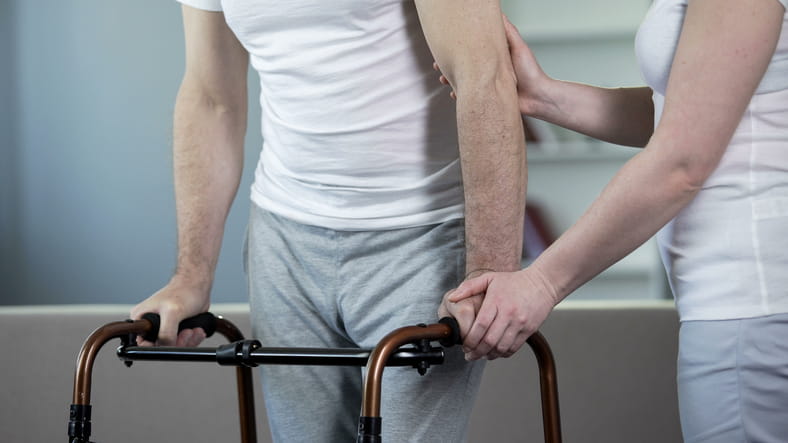What To Expect During Short-Term Rehabilitation in Skilled Nursing
Short-term rehabilitation helps people recover from surgery, illness, or injury. The risk of injuries or chronic health conditions, such as heart disease, increases with age.
Since aging slows the healing process, many older adults need the kind of short-term rehabilitation services offered by skilled nursing facilities. A skilled nursing facility is a place where older adults can reside while recovering. Skilled nursing facilities are staffed by medical professionals who provide expert short-term rehabilitation services for residents, helping them to recover safely and as quickly as possible.
Choosing an exceptional skilled nursing facility, such as those run by Monument Health Group, ensures patients receive expert, customized treatment that promotes their recovery.
What Is Short-Term Rehabilitation?
Common reasons for seniors to need short-term rehabilitation include the following:
- Chronic illnesses, such as diabetes
- Injuries from falls
- Joint replacement
- Stroke
- Surgery
The staff at skilled nursing facilities includes licensed medical doctors, registered nurses, and licensed rehabilitation therapists, including physical, occupational, and speech therapists. These professionals develop treatment plans tailored to each resident’s needs and goals.
Skilled nursing facilities prioritize medical care for individuals recovering from a health event. Short-term rehabilitation can last anywhere from a few weeks to a few months. Medicare pays for up to 100 days of skilled nursing care.
Long-term care focuses on the personal needs of individuals. One key distinction between short-term rehabilitation facilities and long-term care is that the primary goal of short-term facilities is for residents to return home. In contrast, most people in long-term care homes reside there because they require ongoing assistance with daily living tasks. While long-term care facilities offer some medical support, they do not provide the 24/7 medical care typically found in skilled nursing facilities.
Types of Rehabilitation Services Offered
Skilled nursing facilities offer the following rehabilitation services:
- Physical therapy: Physical therapy helps individuals recovering from joint replacement surgery or those with other balance or mobility issues. Physical therapy helps individuals to improve their balance, rebuild muscle strength, and enhance mobility. It also helps people manage pain.
- Occupational therapy: Occupational therapy focuses on the fine motor skills people use to perform daily living tasks, such as buttoning shirts, zipping zippers, and eating. Occupational therapists can teach people who’ve suffered a stroke or a broken bone adaptive strategies, so they can bathe, dress themselves, eat, cook, and perform other routine tasks.
- Speech therapy: Speech therapy involves exercises that help people regain their ability to speak and swallow after illness or injury. Speech therapy helps individuals improve cognitive functions by strengthening their memory, enhancing their problem-solving skills, and increasing their attention span.
Personalized Treatment Plans
The physicians, therapists, and nurses at skilled nursing facilities collaborate to develop personalized treatment plans tailored to each individual in their care. These plans help patients recover as quickly as possible by emphasizing their specific health needs.
The medical team monitors each resident and evaluates their progress. They modify their treatment plans as needed to ensure each person’s recovery progresses. This may involve changing or simplifying treatments, or increasing their difficulty.
The Patient Experience in a Skilled Nursing Facility
Patients at skilled nursing facilities receive personal and medical support around-the-clock. Although medical professionals primarily staff skilled nursing facilities, other staff members also provide emotional support for those in their care and promote social opportunities, recognizing the benefits of social connections and how alleviating loneliness can improve patients’ health and quality of life.
Each patient has a daily schedule that involves personal care, medical treatments, rehabilitation therapy, leisure time, and time to rest. The daily schedules ensure patients have time to recover from treatments and therapy.
Benefits of Short-Term Rehabilitation in Utah
Receiving short-term rehabilitation care in Utah is an excellent option for Utah residents, as it enables them to stay close to family and friends, while residing in a skilled nursing facility. They can receive expert care close to home, which allows them to visit their favorite places during their stay. It also makes it easier for them to return home and begin living independently after their recovery.
Getting Started
Contact skilled nursing facilities in your area to learn about their services and how to receive short-term care. Tour the facility and ask about staff credentials, social opportunities, staff-to-patient ratios, and the types of therapy and recreational activities they offer.
You should also inquire about the cost and the application process for Medicare or Medicaid to cover your stay.
Enjoy the Benefits of Short-Term Rehabilitation in a Skilled Nursing Facility
Short-term rehabilitation facilities provide the expert medical care and rehabilitation therapy older adults need to recover from health issues. Short-term rehabilitation shortens the recovery period by ensuring residents receive customized care tailored to their health needs.
SNF residents benefit from the nursing services, 24/7 access to medical professionals, customized therapy, and collaborative treatment planning that helps them to achieve their recovery goals quickly.
Contact Monument Health Group today to learn how we can help you recover and return home to live independently as soon as possible after a health event.
Sources:
Older Adults. (2024).
SNF Care Past 100 Days. (2025).
Steinhauser, M. (2020). Why Do Older People Heal More Slowly?


